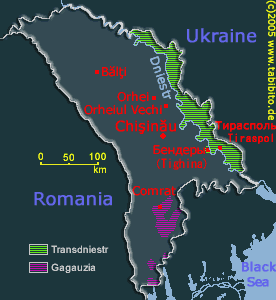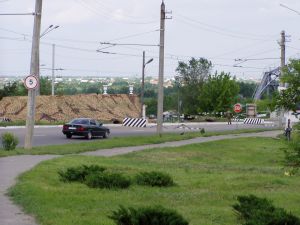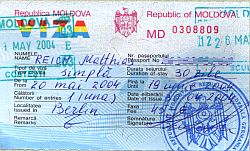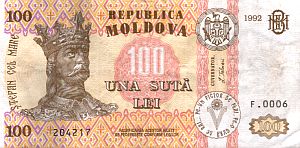|
|
|
|
|
|
 Official Name : Republica Moldova, in English Republic of Moldova.
The Russian name is Молдавия (Moldaviya),
which is one of the reasons why many people confuse the name with Moldavia - the historic
name of East Romania.
Area: 33,843 km² (slightly larger than Belgium, same as Maryland).
Population: 4.4 million* (2003) - (less than half of the population of Belgium).
Due to a high infant mortality rate and a decreasing birth rate, the growth rate is almost zero.
Ethnic groups:
Moldovans/Romanians: 64.5%, Ukrainians: 13.8%, Russians: 13%, Jews: 1.5%, Bulgarians: 2%,
Gagauz (see →Comrat) and others 5.2%.*
Religion:
Almost 98% are Orthodox. 1.5% are Jews. Smaller Baptist and other minorities.
Time zone: Eastern European time: GMT +02 hrs, with daylight-saving time (+1 hour) in summer
Language: Official language is Moldovan, which is almost identical to
→Romanian, which is not a Slavic language and uses
the Latin script with some special characters. In →Transdniestr (PMR),
Russian is far more common and one of the official languages. Many people are bilingual, and so menus,
timetables etc are sometimes in Moldovan, sometimes in Russian and quite often in both languages.
English doesn't really help a lot - at least outside the capital. Most ethnic Germans have left the
country, but there are still many people speaking German more or less fluently. By the way,
there's often a big gap between Russian and Moldovan place names. As for example
→Orhei: Many people don't understand the Moldovan name. Instead of that, they
use the Russian name Оргеев (Orgeyev), which
is obviously quite different.
Official Name : Republica Moldova, in English Republic of Moldova.
The Russian name is Молдавия (Moldaviya),
which is one of the reasons why many people confuse the name with Moldavia - the historic
name of East Romania.
Area: 33,843 km² (slightly larger than Belgium, same as Maryland).
Population: 4.4 million* (2003) - (less than half of the population of Belgium).
Due to a high infant mortality rate and a decreasing birth rate, the growth rate is almost zero.
Ethnic groups:
Moldovans/Romanians: 64.5%, Ukrainians: 13.8%, Russians: 13%, Jews: 1.5%, Bulgarians: 2%,
Gagauz (see →Comrat) and others 5.2%.*
Religion:
Almost 98% are Orthodox. 1.5% are Jews. Smaller Baptist and other minorities.
Time zone: Eastern European time: GMT +02 hrs, with daylight-saving time (+1 hour) in summer
Language: Official language is Moldovan, which is almost identical to
→Romanian, which is not a Slavic language and uses
the Latin script with some special characters. In →Transdniestr (PMR),
Russian is far more common and one of the official languages. Many people are bilingual, and so menus,
timetables etc are sometimes in Moldovan, sometimes in Russian and quite often in both languages.
English doesn't really help a lot - at least outside the capital. Most ethnic Germans have left the
country, but there are still many people speaking German more or less fluently. By the way,
there's often a big gap between Russian and Moldovan place names. As for example
→Orhei: Many people don't understand the Moldovan name. Instead of that, they
use the Russian name Оргеев (Orgeyev), which
is obviously quite different.
|
|
|
|
|
|
|
 The small country of Moldova is sandwiched between →Romania in the west and the
→Ukraine in the east. Due to the fact that there's a small strip of Ukrainian
territory between Moldova and the Black Sea, the country is landlocked. To say that the country is mountainous would be an exaggeration. The highest
peak, Dealul Balanesti, is only 430 metres high. However, almost all of the territory is quite hilly with some more or less deep
river valleys, almost canyon-like, as for example in →Orheiul Vechi at the river
Răut and along the longest river of the country, the Nistru (Dniestr).
The small country of Moldova is sandwiched between →Romania in the west and the
→Ukraine in the east. Due to the fact that there's a small strip of Ukrainian
territory between Moldova and the Black Sea, the country is landlocked. To say that the country is mountainous would be an exaggeration. The highest
peak, Dealul Balanesti, is only 430 metres high. However, almost all of the territory is quite hilly with some more or less deep
river valleys, almost canyon-like, as for example in →Orheiul Vechi at the river
Răut and along the longest river of the country, the Nistru (Dniestr).
Only the small stretch of land east of the Dniestr and the southern part of the country are rather flat - obviously, the seashore of the
Black Sea is close. The border to Romania is marked by the long river Prut, which is also used for energy production in the
north. Most of the country consists of a steppe-like landscape with some forests here and there. The summer is rather long and relatively dry;
winters can become very cold. Unfortunately, the country has no significant mineral resources at all. But it offers quite fertile soils. Here and there,
the surface is dominated by sediments, esp. very young chonchoidal limestone, sand, gravel, gypsum and others.
|
|
|
|
|
|
|
From a historical point of view, present-day Moldova can be divided into two regions:
The first is Bessarabia, which is the region between the river Prut in the west and the Dniestr in the
east; the second is Transdniestr (aka Transdnjestria, Transnestria, Transdnestrien, Transnistria etc)
a small but long stretch of land between the river Nistru/Dniestr and the Ukrainian border. This piece of land is now
occupied by the seceding →PMR (Pridniestran Moldovan Republic), abrr. Transdniestr.
For more details about that area see →History of Transdniestr.
The name Bessarabia has been used for many centuries, but it doesn't seem to be clear where it's
actually coming from. Until the year 1812, Bessarabia belonged to Moldavia, which is today the common name for the eastern part of
Romania with →Iaşi as its former capital. The glorious
Ştefan cel Mare (Stephen the Great), who ruled the mighty Moldovian empire from →Suceava
between 1457 and 1504, can be seen on all Moldovan banknotes today (see picture below). In the middle of the 16th century, Moldavia
incl. Bessarabia was invaded by the Ottoman empires. It remained just a small province inside the vast Ottoman empire until 1812: As a result of
one of many Russian-Turkish wars, the Russian tsar gained control over Bessarabia. He soon invited
German farmers to settle in the area. Hence, there are still many German place names left in Moldova, eg
Marienfeld (Mary's Field) or Jacobstal (Jacob's valley) etc. In old maps, even famous names such as
"Leipzig" can be found. But as already mentioned above, almost all Germans have left the country.
After more than 100 years, things got turbulent. After the October Revolution in 1918, Bessarabia declared its independence from Russia in order
to unite with →Romania. In the year 1940, the Red Army occupied all of Bessarabia.
This was part of the secret deal between Ribbentrop and Molotov, ie Nazi Germany and the Soviet Union.

| |
Russian peacekeeping forces at the Dniestr
|
The Gagauz as well as Slavic minorities (namely Russians and Ukrainians) were afraid about a reunification with Romania and held their
own presidential election in 1991. The tension between the minorities and the government in Kishinev was nothing new, but it eventually developed
into a full-scale civil war between Moldova and Transdniestr in 1992 (to read more about the conflict see
→History of Transdniestr). Only the conflict with the Gagauz could be resolved more or less
peacefully - the Gagauz were granted greater autonomy, and so →Comrat became the capital of
the Gagauz Autonomous Republic.
Indeed - at the end of the 1990ies, there were many rumours about a possible unification with →Romania.
But not for a long time. Today, the subject doesn't seem to be on the table any longer. Nowadays, Moldova faces a serious
trade deficit and an enormous foreign debt burden. By the way, the Communist Party won 50.1% in the last election (2001), which is unique in
Europe: Moldova is the one and only country with a communist president since the 1990ies. Thus, I wonder why there are so many problems with
the communist →PMR.
|
|
|
|
|
|
|
Visa:
Except for citizens of the former Soviet Union, almost everyone requires a visa.
Visas are issued at domestic Moldovan embassies as well as in the Consulate of the Republic of Moldova in
→Bucharest, which takes a few hours only. Some people say that it's also possible
to get the visa upon arrival at the airport and at major border crossings. Well, Moldovan visa regulations seem to change quickly,
so I wouldn't rely on getting a visa upon entry.

| |
Moldovan Visa - good for 30 days
|
If you want to avoid all the hassle at the embassy in your country, you might also obtain a visa at the consulate in Bucharest.
Bring a photo, your passport and the fee (to be paid in Romanian Lei). However, check with the embassy first whether you need
a letter of invitation. Here's the address:
Consulat Republicii Moldova
Blvd. Eroilor 8
Bucureşti, Románia
Tel.: +40 (0)1-410 9827
Restrictions: According to the embassy, everyone needs to register with the
local authorities within three days. This is not necessary when you stay in a hotel. The hotel issues a sheet of
paper confirming the accommodation. All of this paperwork needs to be handed over when you leave the country.
So much about the theory. We stayed with a family in a small village for two days and after that in a hotel for a couple of
nights. We didn't register with the police. The hotel issued a paper, but no one was interested in anything else than
our passports (it was a minor border crossing used by locals only). Nevertheless it's advisable to follow the rules and keep all the papers.
At the border, everyone needs to fill in a foreign currency registration form. Again, this paper is important
and has to be given back when leaving the country. When you have more money when you leave than you've had
upon arrival, you will be in trouble - the money will be taken away. So much about the theory. But no one checked our
personal finances or the registration forms.
Money: As in Romania, the Moldovan currency is called
Leu (plural: Lei), with 1 Lei = 100 Bani. Since the government has floated
the money, the Moldovan Lei has become freely convertible. In May 2004, the average exchange rate
was around € 1 = 14 Lei.

| |
Moldovan 100-Lei bill
|
Coins come in 5, 10, 25 and 50 Bani denominations, but coins are not very often used.
Banknotes come in 1, 5, 10, 25, 50, 100 and 200 Lei. The 1-Leu bill is the most often used bill,
and it's definitely advisable to built up a good stock of 1-Leu bill! As a matter of fact, this comes
automatically. Attention: Moldovan money is not valid in →Transdniestr,
but it can be exchanged there.
There are some ATM's in the capital and in bigger cities such as →Bălţi
and →Orhei. But don't expect ATM's in smaller towns. ATM's accept
all common credit cards as well as Cirrus and Maestro cards. The usual fee per transaction is 4% but at least € 4.
There are exchange booths everywhere, but it's wise to compare the exchange rate of several booths first.
Costs: Because of the rather poor economic situation of the Republic of Moldova,
the country naturally appears to be a very cheap destination for western visitors. By far the most expensive
item is accommodation - in the capital, visitors pay at least € 10 for a night
unless you know someone there. Eating out is very cheap, too, but there are also
some expensive restaurants. A main dish in more or less upmarket restaurants cost between 15 and 60 Lei
(€ 1~ € 4), a cup of coffee is around 2 to 3 Lei. Public transport
is extremely cheap - the ride from →Chişinău (Kishinev) to
→Bălţi in the north (around 160 km) sets you back 24 Lei (€ 1.7)
only. Marshrutkas (shared taxis) in the metropolitan area (a slight exaggeration) cost between 0.8 and 3 Lei, depending
on the distance. Buses and trains to destinations outside Moldova are quite cheap, too.
If there's an admission fee, then it's a few cents only. Some cafés have
internet access. The price for one hours is around € 1. As in every other
CIS-country (except for the Baltic States), alcohol and cigarettes are astonishingly cheap.
It's no problem at all to get by on around € 20 per day, highly depending on the accommodation.
When staying with a family or friends and buying food at the local market, it's also possible to get by on
€ 5 or so. Which doesn't come as a surprise - the average monthly salary is € 50 only.
Getting there: By bus, train or plane. There are some
direct flights from Germany, Austria, →Romania etc
to the capital →Chişinău. If it's a Romanian carrier, there's
likely to be at least one stopover in Romania.
When coming from the west by train or bus, it's inevitable to cross →Romania.
One international train departs from →Sofia (Bulgaria), others from
→Bucharest, running via →Iaşi to the
Moldovan capital. Most of them continue via →Tiraspol to the Ukrainian
capital →Kyiv (Kiev). Many of them are night trains. The gauge is wider than in the rest of Europe,
since Moldova still has the old Soviet railway system. This means that the train stops at the border for
around three hours to adjust the wheels. There are some direct trains to Voronezh and Moscow in Russia and to
→Minsk in the →Belarus.
It's also possible to go by bus or minibus. There's a daily minibus from Iaşi to Chişinău, which
takes around 5 hours. The same bus continues to →Orhei in the north. The fare
to the capital is 170,000 Romanian Lei (€ 4), to Orhei it's 200,000 Lei.
There are also direct buses from →Bălţi in the north to
→Suceava in the Southern Bucovina (north-east Romania).
The fare is 57 Moldovan Lei (€ 4), and due to time consuming procedures at the border the ride can take up to
6 hours. The main border crossings between Romania and Moldova include
Sculeni (road) and a few kilometres to the south Ungheni (train),
another one is the major crossing at Albiţa - all of them are quite central. There are a few
more minor crossings: Lipcani in the very north, Costeşti (south of Lipcani),
Cahul and Giurgiuleşti far to the south near the
large city of Galaţi.
In contradiction to some reports and rumours, it's not a big problem to cross the border at one of the minor
border crossings. As a matter of fact, the border guards seemed to be very surprised to meet us
at the crossing near Costeşti and used the chance for a longer interview (about our trip and our opinion
about the country etc), but all in all we haven't had any trouble.
There are numerous border crossings between Moldova and the
→Ukraine. However, the biggest and
most convenient crossing lies on the territory of →Transdniestr (PMR)
near Первомайск (Pervomaisc).
This means that foreigners might encounter several problems, which can only solved by a substantial amount
of money. Experts call that bribes. I presume that the border crossing in the very north and
in the south (the latter is on the road to Измаїл (Ismail)
are less problematic, since they aren't in Transdniestr. However, it's almost inevitable to cross Transdniestr
when using the road or the train from Chisinau to →Odesa. The latter is only
150 km away from the capital.
Getting around:
Moldova has around 1,300 km railway tracks, which is not really a lot. Additionally, the train
is not very useful, since there are almost no direct connections between the bigger towns
(actually it looks like the railway was built before the towns were erected - nothing fits!)

| |
Short-distance buses are rather old... but nice
|
Buses are much better to get around. Many of them are very old and might have been stolen from a museum
somewhere. And they soon fill up. It's no problem at all to get from A to the capital. And from there
to B. But getting from A to B without passing the capital sometimes proves to be difficult.
Marshrutkas, the typical ex-Soviet Union shared taxis, are slightly more expensive than busses.
They run along fixed routes and usually don't start before every seat is taken. But Marshrutkas stop
wherever you want, and therefore they are very convenient (providing that you know the route).
Marshrutkas as well as buses depart from the local autogară (bus stations),
which are usually located in or near the city centre.
Food and drinks: See the chapter about food in
→Romania. Very common are dairy products
as for example Brânză (sheep's cheese), Caşcaval (cow's milk cheese), Smetana (the typical thick Russian
sour cream), Tvorog (some sort of cottage cheese, often served sweet with sugar and/or fruits) and so on.
Almost everything is self made and really fresh - there's no large food processing industry and not much is imported.
Quite interesting is the Moldovan way of eating Mâmâligâ
(the famous Romanian corn mush): The corn mush is first dipped into melted bacon, than into fresh garlic and
finally into grated sheep's cheese. Very simple, very tasty and very filling.
Needless to say that Russian dishes such as Pelmeni and Co are very common, too. Basically there are two types
of restaurants - one category serves traditional Romanian/Moldovan food, the other one Italian cuisine.
Both are almost equally present. There's also a McDonalds in the capital. However, there's a lack of restaurants in
smaller towns in the country, but it's possible to buy your own food at the Alimentari (grocery)
or at local street markets.
Vin (wine) is cultivated almost everywhere. The most famous place for the wine production is the
small town of Cricova less than 15 km north of the capital. There, the barrels are stored
underground inside an almost 60 km long tunnel system. The Cricova dry red wine (Merlot, Cabernet Sauvignon and more)
as well as the white wine are definitely worth a try. If there's wine, there must be brandy as well. See
→Transdniestr for some information on Moldovan Brandy.
Of course, Moldova also produces Bere (beer), as for example the brands
"Chişinău", "Vitanta" and "Premium". The latter is really good.
Last but not least the infamous vodka, which is called Rachiu in Moldova. Better stick to the wine -
the Moldovan vodka is not the best...
|
|
|
|
|
|
|
www.lib.vt.edu/subjects/slav Large link collection about Moldova in English.
www.marisha.net
Very helpful website from Marisha - she's living in Kishinev and provides lots of information in English.
She can also help finding accommodation etc.
www.moldova.4pla.net
Extensive website about the country in English.
www.md
Moldovan web portal à la Yahoo
land.salzburg.at/rottens/md2003
From Austria to Moldova by bicycle - interesting travelogue and many photos. German.
www.fhenrichfreise.de
Very nice website of a German Moldova-Fan. Well done.
www.net.md/tourism
English website on Moldova - nice layout, too. And helpful.
http://www.turism.md
Also helpful: English website for (potential) visitors of the country.
Do you have or do you know a good website on Moldova? Don't hesitate, let me know!
After checking it, I would love to add it to the link list.
Please note that commercial websites will be declined. For e-mail link see menu on the left.
|
|
| |